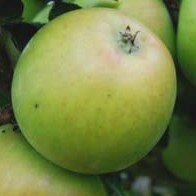Edward VII
Why you should be excited
Edward VII is an early 20th century English cooking apple that’s got plenty of good attributes.
The story of Edward VII
People living in areas prone to late frosts -– as in, right in the middle of apple tree blooming time –- face a big challenge. Every year, they risk losing their entire crop.
Which is why late-blooming apples like Edward VII –- which shows its flowers about three weeks after the earliest bloomers –- have a definite appeal.
For those of us facing less risk of frost during bloom, Edward VII still has a lot going for it. Not only does it cook to a well-flavoured, pretty, translucent, cream-coloured puree; it also is quite serviceable as a fresh eating apple.
Which is an appealing combination, even for those of us who aren't attracted to this named-for-a-king variety due to being enthusiastic monarchists.
Edward VII Facts
Its origins
Bred in Worcester, England; 1908 introduction.
Flavour, aroma, texture
As a cooker, it makes a well-flavoured, translucent puree. For fresh eating, it has a brisk, pleasant flavour.
Appearance
A fairly large, flattish-shaped, green-yellow apple.
When they’re available
Late season (usually in mid-October).
Quality for fresh eating
Good, considering it's mainly treated as a cooking apple.
Quality for cooking
Very good.
Quality for cider
While it doesn't have a particular reputation for use in cider, Edward VII, like other heritage varieties, could add high-quality bulk to ciders.
Keeping ability
Very good (about 5 months when kept refrigerated).



